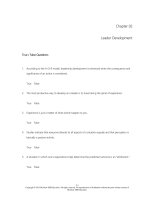Leadership enhancing the lessons of experience 8th by hughes curphy chap 16
Bạn đang xem bản rút gọn của tài liệu. Xem và tải ngay bản đầy đủ của tài liệu tại đây (325.43 KB, 17 trang )
Copyright © 2015 McGraw-Hill Education. All rights reserved. No reproduction or distribution without the prior written consent of McGraw-Hill Education.
Copyright © 2015 McGraw-Hill Education. All rights reserved. No reproduction or distribution without the prior written consent of McGraw-Hill Education.
16-1
Chapter
16
Skills for Optimizing
Leadership as
Situations Change
16-2
Introduction
Advanced leadership skills are needed in specific
situations and when situations change. This chapter
will cover the following topics.
•Creating a compelling vision
•Managing conflict
•Negotiation
•Diagnosing performance problems in individuals,
groups, and organizations
•Team building at the top
•Punishment
16-3
Creating a Compelling Vision
• Leaders often struggle to give a compelling
description of how they add value and to get
anyone excited to become part of their team.
• The vision should be a short, concise, personal
statement that answers several questions.
1. Where is the team going, and how will it get there?
2. How does the team win, and how does it contribute to
the broader organization’s success?
3. How does the speaker define leadership?
4. What gets the speaker excited about being a leader?
5. What are the speaker’s key values?
16-4
Creating a Compelling Vision
(continued)
Figure 16.1: The Four Components of a Leadership Vision
16-5
Managing Conflict
• Conflict occurs when opposing parties have
interests or goals that appear to be incompatible,
such as when team members:
1. Have strong differences in values, beliefs, or goals.
2. Have high levels of task or lateral interdependence.
3. Are competing for scarce resources or rewards.
4. Are under high levels of stress.
5. Face uncertain or incompatible demands.
• Conflict also occurs when leaders’ actions are
inconsistent with their stated goals and vision.
• Breakdowns in communication are the most
important source of conflict.
16-6
Managing Conflict (continued)
The conflict resolution process is affected by several
factors.
•The nature of the conflict
– The size of an issue
– The extent to which the problem is defined egocentrically
– The existence of hidden agendas
•Seeing a conflict situation in win–lose or zero-sum
terms
•Perceiving the conflict as unresolvable
16-7
Conflict Resolution Strategies
Thomas described five conflict management
approaches based on dimensions of cooperativeness
vs. uncooperativeness and assertiveness vs.
unassertiveness.
• Competition reflects a desire to achieve one’s own ends at
the expense of someone else. This is domination, also
known as a win–lose orientation.
• Accommodation reflects a mirror image of competition—
entirely giving in to someone else’s concerns without
making any effort to achieve one’s own ends. This is a tactic
of appeasement.
16-8
Conflict Resolution Strategies
(continued)
– Sharing is an approach that represents a compromise
between domination and appeasement. Both parties give
up something, yet both parties get something.
– Collaboration reflects an effort to fully satisfy both parties.
This is a problem-solving approach that requires the
integration of each party’s concerns.
– Avoidance involves indifference to the concerns of both
parties. It reflects a withdrawal from or neglect of any
party’s interests.
16-9
Five Conflict Handling Orientations
– Resolution Strategies
16-10
Negotiation
Fisher and Ury developed negotiating tips.
1.Prepare for the Negotiation: Considerable time
should be spent in preparation for the negotiation.
2.Separate the People from the Problem:
Negotiations involve substantive issues and
relationships.
3.Focus on Interests, Not Positions: It is important
to focus both on your counterpart’s interests (not
position) and on your own interests (not position).
16-11
Diagnosing Performance Problems
Performance =
ƒ(Expectations x Capabilities x Opportunities x Motivation)
•The model is a framework for understanding why a
follower or team may not be performing up to
expectations and what the leader can do to improve
the situation.
•Because it is a multiplicative rather than a
compensatory model, a deficit in any component
should result in a substantial decrement in
performance that cannot be easily made up by
increasing the other components.
16-12
Components of the Model of Performance
• ƒ(x)
function: maps values of x to ƒ(x) = 3x + 5
• Expectations: Performance problems often occur
because individuals or groups do not understand what
they are supposed to do.
• Capabilities: Followers cannot always do things just
because they understand what they are supposed to do.
Abilities and skills are the two components of capabilities.
• Opportunities: Followers may lack the opportunity to
demonstrate acquired skills.
• Motivation: Will followers or groups choose to perform or
exhibit the level of effort necessary to accomplish a task?
16-13
Team Building at the Top
Executive teams are similar to other types of teams but
different in two ways.
1.Most top teams never function as a whole, so when a
situation arises, team members must use their individual
skills and high-performance teamwork.
– Leaders must have the diagnostic skills to discern
whether a challenge involves an individual situation or a
team situation.
– Leaders must “stay the course” when a team situation is
present.
2.Executive teams have an opportunity to enhance
teamwork throughout the organization, and only
executive teams can change organizational systems.
16-14
Tripwire Lessons
Trip Wire 1: Call the performing unit a team but
really manage members as individuals
Trip Wire 2: Create an inappropriate authority
balance
Trip Wire 3: Assemble a large group of people, tell
them in general terms what needs to be
accomplished, and let them “work out the details”
Trip Wire 4: Specify challenging team objectives,
but skimp on organizational supports
Trip Wire 5: Assume that members already have all
the competence they need to work well as a team
16-15
Punishment
• Punishment is the provision of an undesirable
consequence or the withdrawal of a desirable
consequence, which in turn decreases the
likelihood that a particular behavior will be
repeated.
• Arvey and Ivancevich reviewed three myths about
punishment.
1. Punishment results in undesirable emotional side
effects on the part of the recipient.
2. Punishment is unethical and inhumane.
3. Punishment rarely works anyway.
16-16
Administering Punishment
To make punishment effective, leaders should:
•Recognize their bias toward internal attributions.
•Gather as many facts as possible before deciding
whether to administer punishment.
•Focus on the act, not the person.
•Be consistent across both behaviors and leaders.
•Clarify the rationale and identify the future
consequences of misbehavior.
•Provide guidance about how to improve.
16-17









